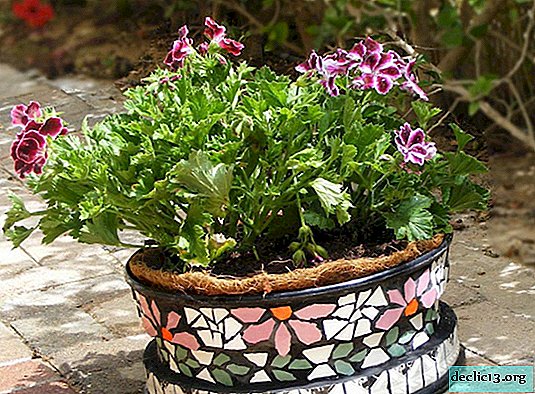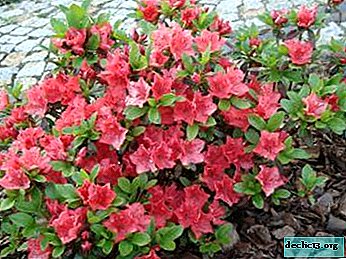9 tips for amateur gardeners: how to make an orchid blossom

Orchid is one of the most unusual and mysterious plants. This culture is eye-catching with its delicate flowers. But sometimes it happens that an orchid for a very long time does not open buds, which very upsets its owners. We are not talking about those cases when the culture needs a modest rest, but about those in which the plant does not please others with flowering for more than a year and a half. Then the florist seriously thinks: what should be done with your darling if she does not bloom?
In this article we will explain why this happens and how to make the plant bloom at home, including repeatedly, that is, what measures can be taken to stimulate flowering.
Flowering time
In natural habitats, this culture begins to bloom in March-April., and closer to the fall, drops the buds and begins to prepare for a period of rest and recovery. But at home, everything is completely different: a constant climate is maintained there, so the culture can begin to bloom at any time - from January to December.
Important! You should be alerted by the fact that flowers have not appeared on the plant for more than a year. In this case, it is time to take action.Why did the plant go on strike?
It happens that a green pet does not bloom for a long time, sometimes even 2 years or more. We list all the possible reasons for this:
 Not enough light. And it should be a lot. But recall that the lighting must be diffused. In no case do not allow direct sunlight to fall on the greenery of the plant.
Not enough light. And it should be a lot. But recall that the lighting must be diffused. In no case do not allow direct sunlight to fall on the greenery of the plant.- Too often moisten the soil. The fact is that in the homeland of this flower during torrential rains there are no insects at all, that is, the pollination process does not occur. At home, an orchid lives by the same principles: a lot of water, then it is not the time to blossom. Try to arrange a drought for the culture - this will be the impetus for flowering.
- A lot of fertilizer or improperly selected nutritional complex. If the green part of the plant grows well, and you still can’t observe flowering, it means that there is too much nitrogen in the fertilizers, but not enough phosphorus (it is he who is responsible for opening the buds).
- The substrate does not fitin which the orchid is planted. It should not be an ordinary garden. We recommend buying soil intended for growing this particular crop.
- Wrong pot. It should be transparent and smooth. There are two reasons for the transparency of the flowerpot. First, you must constantly monitor the state of the root system. Secondly, the roots also need lighting, which can only provide a transparent capacity.
- Temperature. It should not be below 15 degrees in the winter and above 25 degrees in the summer. Also make sure that the difference in day and night temperatures is kept within 4-5 degrees.
You can find out more about why the plant does not bloom and what to do with it here.
Is it possible and necessary to artificially stimulate the process?
Many gardeners want to extend the flowering period, so they do everything in order to force the orchid to re-open the buds, using different flowering stimulants. But such procedures can only be carried out with an adult culture that has reached at least three years of age. And only once every two or three years, because no matter how you twist, and the orchid must rest and recover.
Does baby maturation accelerate?
On a note. All experienced flower growers are reduced to a negative opinion about whether it is worth stimulating a baby to bloom.For the first time, a plant can bloom in two years. This is normal. After all at first, the culture should be strengthened in the roots and shoots and only after that spend energy on flowers. Therefore, we strongly recommend patience. There will be nothing good from artificial stimulation, especially in children.
9 rules for flowering
Do you want to admire the tenderness of orchid flowers as often as possible and longer? Create optimal conditions for her. This is not so difficult to do.
We will tell you more about how to stimulate flowering at home in 9 rules that have been tested for years. Compliance with them will certainly lead to the fact that the orchid will be on time, for a long time and plentifully bloom.
 It's all about age. We have already said that young plants may not bloom until about two years. This is not to be afraid. Shoots tell that the culture is ready to withstand such hard work as flowering. There should be at least five. You may be scared only by the fact that the culture already has more than the specified number of shoots, and it still does not open buds.
It's all about age. We have already said that young plants may not bloom until about two years. This is not to be afraid. Shoots tell that the culture is ready to withstand such hard work as flowering. There should be at least five. You may be scared only by the fact that the culture already has more than the specified number of shoots, and it still does not open buds.- Do not move the pot. Relocation for orchids always responds to a stressful state. And here we have in mind not some global movement, but even the slightest change in position relative to lighting. if the question arises about the urgent need for relocation of the flowerpot, put it so that the angle of illumination does not change.
- Pay attention to the rhizomes. We have already talked about them in the article above. But recall: there should not be any rough and colored pots. Only transparent and only smooth surface. Remember that the one hundred root system, along with leaf blades, is involved in photosynthesis, so take care of the access of light to the roots.
- A bit about lighting. If you do not provide a long daylight hours, which should last 10-12 hours a day, the orchid will not bloom. If this cannot be done naturally, seek artificial lighting for help. Now even there are special phytolamps created specifically for plant lighting. But beware of burns on the leaves. To do this, avoid direct sunlight on the orchid.
- Do not forget about the temperature difference. Not only will you have to maintain the optimum temperature for the crop, now one more thing has been added to this requirement: providing a five-degree difference during the day. (That is, five degrees higher during the day than at night. But no more!)
If in the warm season orchids are located in an open space, then this condition is met by itself. Also, do not forget to ventilate the room in which there is a flower pot. But beware of drafts that culture cannot tolerate.
- You need to moisten the soil correctly. This can only be done after two to three days have passed after the topsoil has dried. Watering should be slightly reduced even after the orchid has bloomed - let the soil stay dry for about a month. Experienced gardeners recommend watering the plant in two ways: by immersion and under the shower.
In the first case, immerse the flower pot in a container of water and leave it there for about ten minutes. This time will be enough for the culture to completely “get drunk”. In the second case, put the pot in the bathtub and shower it, then let the water drain and put the orchid in its original place.
- Humidification. Do not forget about this procedure. Unlike soil, the air around orchids must be constantly moistened. To do this, simply place a container of water near the flower pots. And also as often as possible spray both the green part of the culture and its flowers.
- Competent fertilizer. In the case when you feed the plant only with nitrogen fertilizers, only leaves and roots will grow, and there will be no flowers. Therefore, refer to complexes in which there is more potassium and phosphorus - these elements are responsible for the flowering of orchids.
Recommendation. Do not experiment with self-preparation of fertilizer, it is better to buy ready-made in specialized stores. There you will be told about the doses and recommendations for different varieties of this plant.
- Stress is sometimes helpful. It so happens that all the conditions are created, and blooming buds can not be seen. This is due to the fact that culture is already very good, and it is not going to do anything. Shake the measured existence of an orchid. This can be done by a long break in watering or lowering the standard temperature.
About what to do if the orchid does not bloom, we suggest reading in this material.
How to improve the condition of the plant?
 Here, first of all, you need to pay attention to the nuances of the orchid's well-being. If she does not grow leaves or flowers, then the reason can be only one: you do not follow the rules for caring for the plant, described above. May not get any one point, or maybe you do not perform several tips at once. remember, that the orchid is also alive, so chaotic care for it will not work, In this case, everything should be according to the instructions. We did not invent them - it is not for us to cancel them.
Here, first of all, you need to pay attention to the nuances of the orchid's well-being. If she does not grow leaves or flowers, then the reason can be only one: you do not follow the rules for caring for the plant, described above. May not get any one point, or maybe you do not perform several tips at once. remember, that the orchid is also alive, so chaotic care for it will not work, In this case, everything should be according to the instructions. We did not invent them - it is not for us to cancel them.
If a plant produces only roots and leaves, then with full confidence we can say that you went too far with nitrogen fertilizers. They stimulated the active development of the green part of the flower, which in turn stopped the growth of flower buds. Fertilizers should be variable (one week - nitrogen, another week - potassium and phosphorus) or complex (here you definitely will not lose, therefore it is better to choose this option).
Stimulation by regulating watering and lighting
So what to do to make the orchid bloom?
- How to speed up flowering? This can be done by reducing watering to once every two weeks. (Sometimes you can let it dry for a month.)
- On watering days, do not fill the flower very much. Immersed in a container of water, waited 10 minutes, removed from the container. (In case of excess moisture, the root system will begin to rot.)
- Move the flowerpot to a dark place for about a week.
- After this manipulation, provide the plant with long daylight hours (10-12 hours per day), the lighting should be more than adequate. With less light, you will not wait for flowers.
It is impossible not to agree with what the most beautiful delicate buds made the orchid so popular among gardeners: both professional and amateur. But, probably, if the flowers were constantly present on her, they would not be so desired. Everything inaccessible attracts us. This can be said about orchid. Therefore, we did not tell how to make the orchid blossom all year round. Do not try to achieve this, because because of this, the flowers will become smaller, their abundance will decrease, and the colors will lose their saturation.
Useful video
Watch a video on how to make an orchid blossom:

 Not enough light. And it should be a lot. But recall that the lighting must be diffused. In no case do not allow direct sunlight to fall on the greenery of the plant.
Not enough light. And it should be a lot. But recall that the lighting must be diffused. In no case do not allow direct sunlight to fall on the greenery of the plant. It's all about age. We have already said that young plants may not bloom until about two years. This is not to be afraid. Shoots tell that the culture is ready to withstand such hard work as flowering. There should be at least five. You may be scared only by the fact that the culture already has more than the specified number of shoots, and it still does not open buds.
It's all about age. We have already said that young plants may not bloom until about two years. This is not to be afraid. Shoots tell that the culture is ready to withstand such hard work as flowering. There should be at least five. You may be scared only by the fact that the culture already has more than the specified number of shoots, and it still does not open buds.















